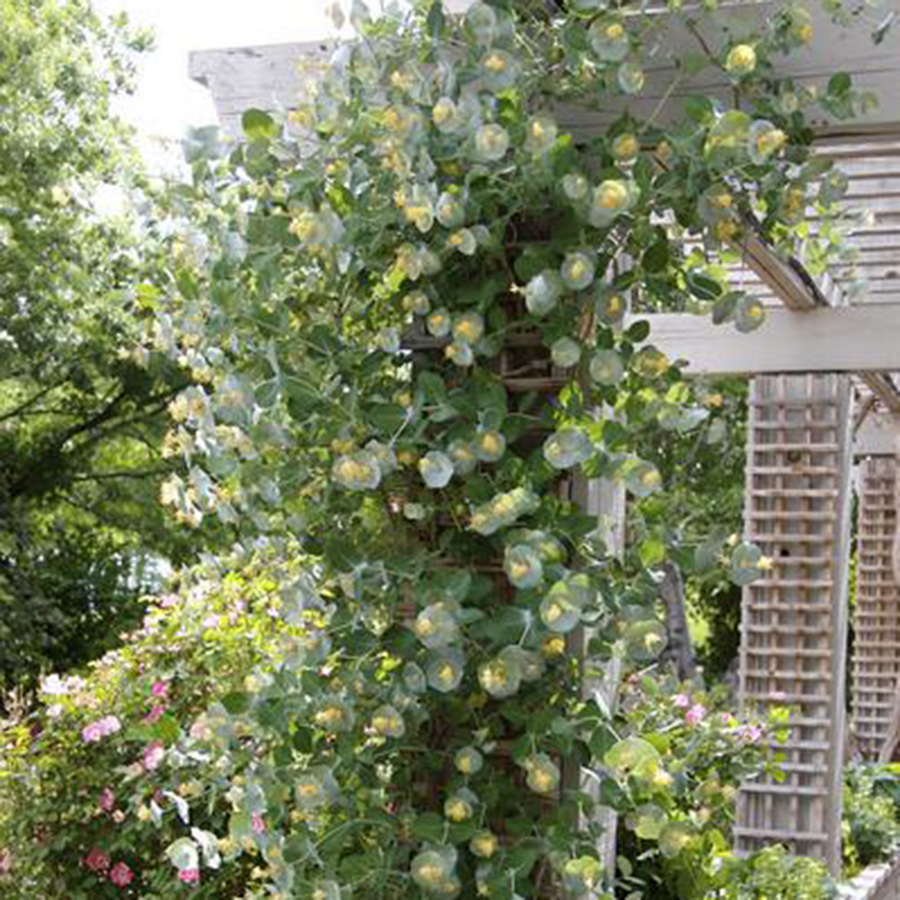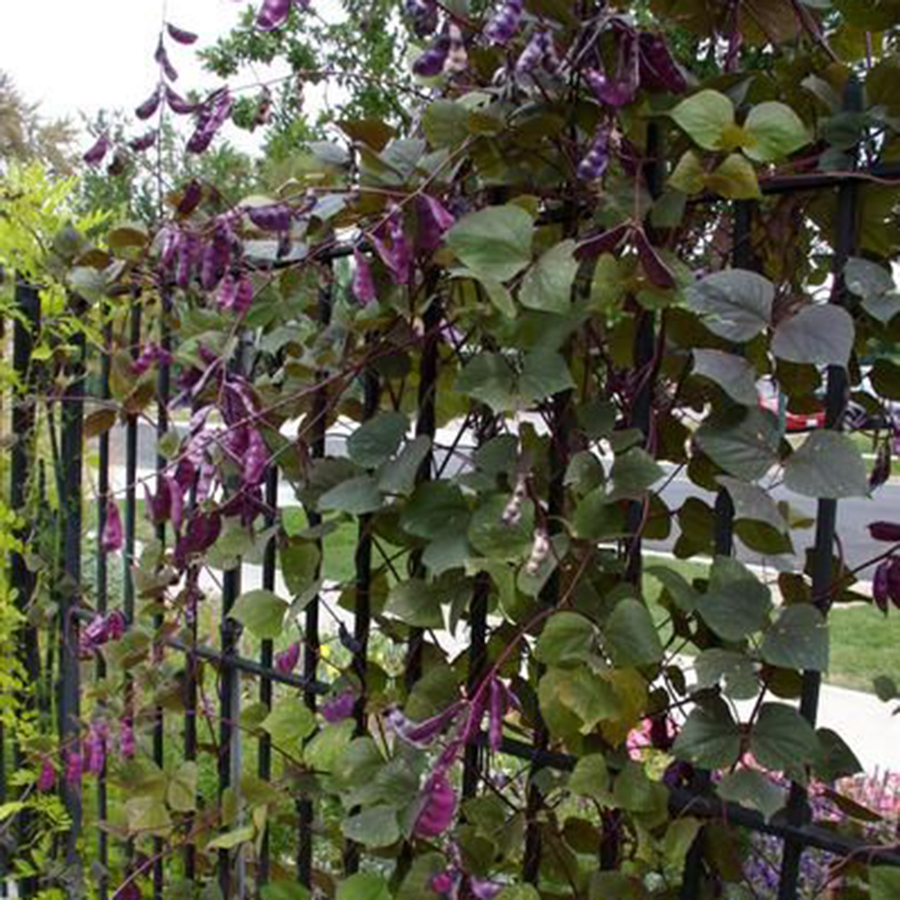To Vine Own Self Be True
- 2022-07-07
- By mkirk
- Posted in Horticulture, The Garden Buzz
By Donnetta Wilhelm, Colorado Master Gardener
Imagine living in a strictly horizontal dimension, gazing across an endless, flat landscape. The eye desires to see vertical elements; trees, tall shrubs, and structures such as fences and arbors. When adding vertical dimension, don’t overlook using vines and climbing plants which adds interest to the horizontal elements and draws the eye upward to create a sense of height. They can make a small space feel larger, or make a large space feel less open and more ordered. Use of vines and climbers can frame a gorgeous view, function as a screen for more privacy, or even serve as a focal point within the landscape.

Clematis, The “Queen of the Vines”
Boasting 300 species and 2,500 cultivars, Clematis is Greek for “climbing plant” and uses winding petioles to climb. Clematis require cool soil for the roots and full sun for gorgeous blooms. Clematis are grouped by pruning requirements. The plant tag will identify it as Group A, B or C (or 1, 2, 3) and should be pruned according to this Pruning 101 Guide. Late-blooming Sweet Autumn Clematis displays profuse tiny white flowers and a sweet scent in the autumn months, which is why this climber is a great addition to the landscape, thriving in sun to part shade.
Honeysuckle Lovelies

“Sweet and intoxicating” is the term most associated with the smell of honeysuckle. Hall’s Japanese is the most commonly grown honeysuckle in Colorado. Blooming from May to frost, followed by black berries in the fall, it requires a structure for climbing. This popular vine tolerates poor soils and part shade. Trumpet Honeysuckle (Lonicera sempervirens) is native with scarlet-orange flowers that bloom heavily through the summer, attracting hummingbirds. This vine also needs support and can grow in full sun or shade and has low water needs. Kintzley’s Ghost Honeysuckle has seen a popularity surge in Colorado with its heartwarming history and receiving the Plant Select® Award Introduction in 2006. At 10 feet tall, it is grown best in full sun and requires sturdy support. Yellow, tubular flowers attract butterflies and hummingbirds, and is drought tolerant.
America’s Flower: Roses

Some of the most beautiful climbing plants are roses. If Japanese beetles persist, treatments are available, and these beautiful treasures can still be enjoyed in the landscape. ‘John Cabot’ and ‘William Baffin’ are hardy Canadian climbing roses that bring superb fragrance and beauty, while dainty ‘Jeanne Lajoie’ can brighten the landscape even in a part-shade area. ‘Joseph’s Coat’ climbing rose has been noted in Dr. Whitney Cranshaw’s CSU research to show no feeding from Japanese beetles.
Berries, Scents, and Ornamentals
Goji Berry ‘Firecracker’ is a self-clinging, vine-like shrub with small clusters of blooms in early summer with reddish berries in summer and fall. Hardy to Zone 5, it grows 6 feet tall and prefers full sun. The Five Leaf Akebia vine can reach 20 feet and has dangling stalks of chocolate-scented, deep purple flowers in the late spring and will not tolerate hot afternoon sun. Native to Asia, the vines are used in basket weaving.
Vertical plants don’t always need to be perennial. Don’t leave out annual vines that attract pollinators, and provide lovely scents and profuse color until first frost. Passionflower ‘Blue Bouquet’ is an annual that reaches 10 feet tall, requires full sun, and has large, showy, scented flowers excellent for summer bouquets. Black Eyed Susan vine is an annual that grows to 8 feet in full sun. Twining stems with heart-shaped leaves with flowers in every color can brighten the landscape or a patio container where a vertical element is desired. Hyacinth Bean ‘Ruby Moon’ is an annual offered by Plant Select®. A bean cousin with an 8-foot twining habit is good for containers or in the ground. Plant in full sun and enjoy the dark purple foliage with clusters of blue and amethyst flowers attracting bees and butterflies. An added bonus: the attractive flat purple bean pods.

Go For Green
Vertical elements do not necessarily need to possess flowers to add beauty. Purpleleaf Wintercreeper has ivy-like growth and can climb nearby structures and walls. It is shade tolerant, evergreen, and turns a beautiful plum color during the cool season. English ivy is a favorite evergreen that comes in many varieties, does well in shade, and requires no trellis support. This is a good vertical element in a north facing location protected from harsh afternoon winter sun. CSU notes this climber can reach 30 feet in Colorado. ‘Thorndale,’ ‘Duckfoot’ and ‘Gold Child’ varieties do well in Colorado.
Floriferous Wisteria
With careful selection, classy, elegant wisteria can be grown along the Front Range. Perfumed and showy, wisteria needs a solid, permanent support such as an arbor or pergola. Plant it in a protected location from late frosts, then prune twice per year: a light pruning in midsummer and a hard pruning in late winter. For best blooming, plant Wisteria in full sun and provide consistent moisture. Several varieties are hardy to Zone 5 with Aunt Dee Kentucky and Texas Purple (Japanese) being the most successful.
Avoid
Gardeners can find a wide range of vertical plants in garden centers. For in-ground, perennial planting, avoid tropical plants as they are expensive and will not survive the first frost. These include: Mandevilla, Bougainvillea, Jasmine, or Plumeria. It is also best to avoid many of the plants that Japanese beetles highly favor: Grape (ornamental or fruiting), Silver Lace Vine and Virginia Creeper. Also avoid invasive species such as Trumpet Vine (Campsis radicans).
Grow Up
Consider a vine or climbing plant to serve as a divider of endless horizontal space. A vine can be used as a filler in a narrow space, a privacy screen, an alternative where a shrub or tree isn’t possible, or even for shade when used over an arbor or pergola. Vines and climbers are multi-functional, adding charm and grace to the landscape.
Horticulture Resources
- Garden Buzz Archives
- CSU Extension Resources
- Colorado Master Gardener Program
- Foothills to Plains Native Plant Master Program
- Native Bee Watch Community Science Program
- The Co-Hort Blog
- PlantTalk Colorado
- Soil Testing
- Plant Select
- Emerald Ash Borer
- Japanese Beetle
- Colorado State Forest Service
- Ask an Expert


